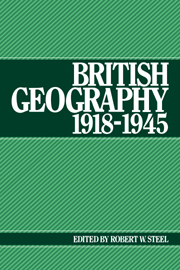Book contents
- Frontmatter
- Contents
- Preface
- 1 The beginning and the end
- 2 Geography during the inter-war years
- 3 Geography in the University of Wales, 1918–1948
- 4 Geography at Birkbeck College, University of London, with particular reference to J. F. Unstead and E. G. R. Taylor
- 5 The Oxford School of Geography
- 6 Geography in the Joint School (London School of Economics and King's College)
- 7 Geography in a University College (Nottingham)
- 8 Geographers and their involvement in planning
- 9 On the writing of historical geography, 1918–1945
- 10 Physical geography in the universities, 1918–1945
- 11 Geographers and geomorphology in Britain between the wars
- 12 British geography, 1918–1945: a personal perspective
- Index
10 - Physical geography in the universities, 1918–1945
Published online by Cambridge University Press: 07 October 2009
- Frontmatter
- Contents
- Preface
- 1 The beginning and the end
- 2 Geography during the inter-war years
- 3 Geography in the University of Wales, 1918–1948
- 4 Geography at Birkbeck College, University of London, with particular reference to J. F. Unstead and E. G. R. Taylor
- 5 The Oxford School of Geography
- 6 Geography in the Joint School (London School of Economics and King's College)
- 7 Geography in a University College (Nottingham)
- 8 Geographers and their involvement in planning
- 9 On the writing of historical geography, 1918–1945
- 10 Physical geography in the universities, 1918–1945
- 11 Geographers and geomorphology in Britain between the wars
- 12 British geography, 1918–1945: a personal perspective
- Index
Summary
What was meant by physical geography? In the years following 1918 most people probably included in their answer what was in the then standard book on the subject, Physical Geography, by Philip Lake, which was first published in 1915. It was in three sections – elementary meteorology and climatology, oceanography and landforms. It was finally printed in 1958, having been considerably enlarged and in part re-written. Nevertheless, for about half a century it was used both for first-year work at universities and for sixth-form work in schools. But during that time the subject had expanded greatly, and in the 1930s several more specialist books were written and were in general use. But advanced courses in physiography or geomorphology could not be attempted without the reading of many papers, largely, but not wholly, on fieldwork and research into the origin of landforms and related matters. These appeared in scientific journals, mainly of geology and geography. Although some courses still required a knowledge of climate and meteorology and possibly of oceanography, these subjects at an advanced level were basically the field of physicists, chemists and biologists. I have stressed advanced level; a general knowledge of both oceanography and climatology with meteorology was doubtless taught in several departments, and at Cambridge, until recent changes, reasonably detailed lectures were given in both subjects.
- Type
- Chapter
- Information
- British Geography 1918–1945 , pp. 138 - 155Publisher: Cambridge University PressPrint publication year: 1987
- 5
- Cited by



